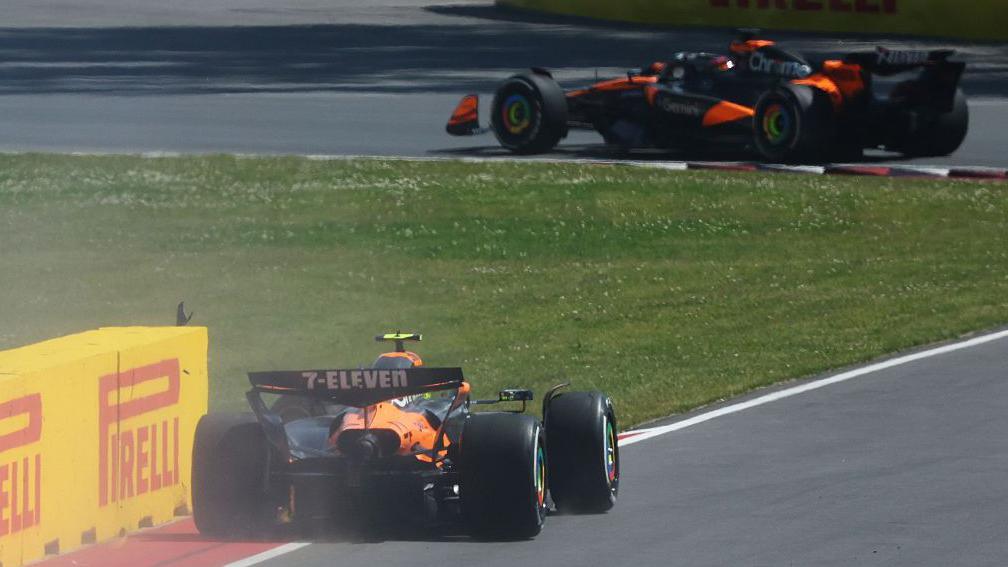The Canadian Grand Prix recently witnessed an intensifying rivalry and noteworthy performances that captivated fans around the world. In a significant turn of events, McLaren teammates Lando Norris and Oscar Piastri collided, dampening Norris’s race and contributing to Piastri’s continued upward trajectory in the championship standings. Despite this on-track drama, George Russell of Mercedes seized the opportunity to claim victory, marking the team’s first win of the season amid challenging circumstances.
With just four laps remaining in the race, Norris, in a bid to overtake Piastri for the fourth position, misjudged his approach and collided with his teammate’s car on the pit straight. The incident led to an immediate retirement for Norris, who accepted responsibility, radioing his team to express remorse for his reckless maneuver. “It’s all my bad; it was stupid of me,” he acknowledged, displaying accountability for the collision that left his car with significant front suspension damage. Piastri, although shaken by the event, managed to continue racing, ultimately finishing in fourth place as the safety car was deployed at the end of the race.
George Russell’s performance was particularly commendable; he maintained control throughout the race after starting from pole position. During the initial laps, he effectively outmaneuvered Red Bull’s Max Verstappen and built a comfortable lead—though it never exceeded 5.5 seconds. Russell’s ability to maintain composure under pressure, particularly during the last stages of the race, underscored his skill as a driver and highlighted the effectiveness of Mercedes’ race strategy. The eventual closing of the gap due to traffic did not hinder his ability to secure the win.
In the broader context of the championship, the collision between Norris and Piastri inadvertently bolstered Piastri’s lead over his teammate to a 22-point advantage. It further complicated Norris’s campaign in the title chase, particularly as Verstappen sat 21 points adrift of Norris. With 14 races still remaining in the season, it’s a setback, but not one that wholly derails Norris’s title aspirations, albeit it reignites scrutiny over his on-track decision-making.
The incident echoed a similar clash between McLaren drivers Lewis Hamilton and Jenson Button in the 2011 Canadian Grand Prix, yet the nuances of both incidents highlighted different circumstances. In 2011, Hamilton had managed to place part of his car alongside Button before the collision, suggesting a shared responsibility. In contrast, Norris’s attempt bore the hallmarks of a miscalculation without sufficient space to attempt the overtaking maneuver, raising questions about his racecraft in critical moments.
Russell’s victory, juxtaposed with his teammates’ fallout, reinforced Mercedes’ resurgence, having converted an impressive pole lap on Saturday into a decisive race win. His calculated management of the race flow with strategic pit stops and effective tire strategies put him in command, allowing him to fend off any potential threats and remain ahead, even when pushed by rival drivers like Antonelli and Piastri later in the race.
The race concluded with significant disappointment for Ferrari drivers, as the team struggled with strategy issues. Charles Leclerc, who finished fifth, voiced his frustrations regarding pit strategies that did not align with his race expectations. Meanwhile, behind the lead drivers, Fernando Alonso continued to garner points for Aston Martin, finishing seventh, while Sauber’s Nico Hulkenberg and the Haas driver Esteban Ocon filled the remaining top ten positions.
In summary, the Canadian Grand Prix proved to be a pivotal moment in the Formula 1 season. The collision between Norris and Piastri not only shifted the dynamics within McLaren but also offered Russell a commanding platform to make his mark. As the championship progresses, every move by drivers like Norris and Piastri will be scrutinized closely, particularly as they vie for the coveted title amidst fierce competition from both Mercedes and Red Bull.



